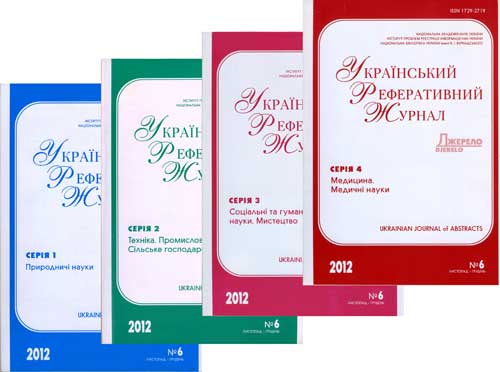РЕФЕРАТИВНА БАЗА ДАНИХ "УКРАЇНІКА НАУКОВА"
Abstract database «Ukrainica Scientific»
Бази даних
Реферативна база даних - результати пошуку
|
|
Пошуковий запит: (<.>ID=REF-0000716203<.>) | |||
|
Загальна кількість знайдених документів : 1 |
|||
Gzhegotskyi M. R. Assessment of lead, cadmium, copper and zinc content in women's blood during II trimester of gestation / M. R. Gzhegotskyi, N. V. Sukhodolska // Експерим. та клініч. фізіологія і біохімія. - 2019. - № 2. - С. 5-10. - Бібліогр.: 14 назв. - англ. The modern ecological situation creates preconditions for increasing the frequency of gestational complications and negative impact on womenіs and childrenіs health. In this regard, the scientific search for risk factors of the potential adverse effect on the gestation process for timely implementation of adequate preventive and corrective measures is of great importance. The purpose of this study was to evaluate lead, cadmium, copper and zinc levels in womenіs blood during the second trimester of gestation and to assess the significance of their influence on the gestational process. The investigation of lead, cadmium, copper and zinc levels in the blood of 40 women with uncomplicated pregnancy and 45 women with gestation complicated by anemia (33,3 %), threatened abortion (40,0 %) and gestational pyelonephritis (26,7 %) was carried out. The indication of metals was evaluated by the inversion voltammetry method. The following criteria were chosen: the second trimester of pregnancy, the homogeneity of social status, the absence of physical, genetic and oncological diseases, burdened obstetric and gynecological history. The average levels of toxic metals in the blood of women with complicated gestation were significantly higher as compared to the physiological course of pregnancy while the content of trace elements was significantly lower. The highest lead concentration was recorded in the blood of women with anemia and the highest cadmium content was recorded in a threatened miscarriage, which were respectively 4,3 and 3,0 times higher than in women without complications. At the same time, women with pyelonephritis had respectively 2,8 and 2,6 times higher lead and cadmium levels. The average copper and zinc content during the second trimester of gestation was significantly lower by 36,4 - 38,7 % as compared with the uncomplicated pregnancy. The lowest levels of trace elements were found in the blood of pregnant women with pyelonephritis that were twice lower than during the physiological pregnancy. Women with a threatened miscarriage and anemia had respectively by 47,0 and 35,9 % lower copper content, and 35,7 and 38,3 % lower zinc content. The lowest level of copper was combined with the decreased zinc content and the high lead concentration. At the same time, the high level of copper was observed in the case of the increased zinc content and the decreased lead level. It has been shown that combined effects of microelements such as cadmium and lead had some provocative action on the increase of the risk of gestational complications whereas copper and zinc had some preventive action. In the second trimester of gestation, the development of a threatened abortion was combined with high levels of lead and cadmium, low levels of zinc and copper, and the risk of anemia was correlated with the low concentration of copper and the high content of lead in the blood of pregnant women. Thus, nowadays in ecological conditions with the increased levels of abiotic substances and the lack of trace elements, the detection of lead, cadmium, copper and zinc levels in womenіs blood can be useful for predicting the individual risk of a threatened abortion, anemia and pyelonephritis. Індекс рубрикатора НБУВ: Р716.11-451 + Р252.711.2 Рубрики: Шифр НБУВ: Ж16160 Пошук видання у каталогах НБУВ | |||
| Національна бібліотека України імені В. І. Вернадського |
 |
| Відділ наукового формування національних реферативних ресурсів |
 |
| Інститут проблем реєстрації інформації НАН України |
Всі права захищені © Національна бібліотека України імені В. І. Вернадського